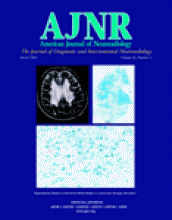Abstract
BACKGROUND AND PURPOSE: Symptomatic cerebral hyperperfusion has an incidence of 5% after endovascular stent placement. We hypothesized that increases in cerebral blood flow (CBF) after endovascular stent placement are positively correlated with the severity of stenosis.
METHODS: We studied patients with carotid (n = 20) or vertebrobasilar (n = 3) stenosis who were undergoing endovascular stent placement. Hemispheric CBF was measured by using intra-arterial xenon-133 technique (initial slope).
RESULTS: CBF increased from 29 ± 10 to 35 ± 12 mL/100 g/min (P = .0003) at 39 ± 12 minutes (range 13–60 minutes) after endovascular stent placement. Baseline characteristics or type of anesthesia did not affect the findings. Physiologic parameters remained constant between measurements: PaCO2 was 43 ± 6 mm Hg and arterial pressure was 89 ± 16 mmHg. The degree of vascular stenosis (70% ± 13%, range, 40–99%) was not correlated with change in CBF (r2 = 0.007, P = .70) or baseline CBF (r2 = 0.005, P = .31).
CONCLUSION: CBF increased by 21% ± 10% after treatment in the absence of clinical symptoms and without intracranial hemorrhage. Modest increases in CBF were common after endovascular revascularization. However, the increased CBF appeared to be unrelated to the degree of vascular stenosis, suggesting a relationship to availability of collateral flow pathways or a neurogenic influence.
- Copyright © American Society of Neuroradiology












